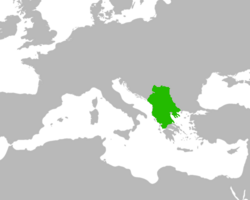Serbian Empire
|
|||||||||||||||||||||||||||||||||
The Serbian Empire (Serbian: Српско Царство, Srpsko Carstvo) was a medieval empire in the Balkans that emerged from the medieval Serbian kingdom in the 14th century. The Serbian Empire existed from 1346 to 1371 and was one of the larger states in Europe.
Contents |
History

Stefan Dusan, before he came to throne as king of Serbia, proved himself as a very talented battle leader, who proved himself in war against Bulgaria, where Serbia heavily defeated the Bulgarian kingdom. As his father wasn't really an able conqueror, Dusan, with the help of Serbian nobility, removed his father from the throne, ordering his people to strangle him. The medieval Serbian state reached its apex in the mid-14th century, during the rule of Stefan Dušan, who proclaimed himself in 1345 emperor (tsar) in Serres and was solemnly crowned in Skopje on April 16 1346 as "Tsar of Serbs and Greeks" by the newly created Serbian Patriach Joanikie II with the help of the Bulgarian Patriarch Simeon and the Archbishop of Ohrid, Nicholas.
Stefan Dušan also introduced Dušanov Zakonik (Dušan's Code, 1349), a juridical achievement unique among the European states of the time. Emperor Dušan opened up new trade routes and strengthened the state's economy. Serbian Empire flourished, featuring one of the most evolved countries and cultures in Europe. Some of Serbia's greatest Medieval arts were created during this period, most notably St. Sava's Nomocanon.
Emperor Stefan Dušan doubled the size of his former kingdom, seizing territories to the south, southeast and east at the expense of Byzantium. He was succeeded by his son Stefan Uroš V, called the Weak, a term that might also apply to the state of the empire, as it slowly slid into feudal anarchy. This is a period marked by the rise of a new threat: the Ottoman Turk sultanate gradually spreading from Asia to Europe and conquering Byzantium first, and then the other Balkans states. Too incompetent to sustain the great empire created by his father, Uroš could neither repel attacks of foreign enemies, nor combat the independence of his nobility. The Serbian Empire of Stefan Uroš fragmented into a conglomeration of principalities, some of which did not even nominally acknowledge his rule. Stefan Uroš V died childless in December 1371, after much of the Serbian nobility had been destroyed by the Turks in the Battle of Marica earlier that year.
Emperors
This article is part of the series on the |
|||
| Medieval Serbia | |||
| Rascia Zeta Doclea Zachlumia, Travunia |
|||
| Serbian Empire | |||
| Moravian Serbia | |||
| Battle of Kosovo | |||
| Serbian Despotate | |||
| Ottoman/Habsburg Serbia | |||
| First Habsburg Serbia | |||
| Second Habsburg Serbia | |||
| Revolutionary Serbia | |||
| Modern Serbia | |||
| Principality of Serbia | |||
| Kingdom of Serbia | |||
| Serbian Campaign (World War I) | |||
| Kingdom of Yugoslavia | |||
| Serbia (1941-1944) | |||
| Republic of Užice | |||
| Socialist Republic of Serbia (as part of SFR Yugoslavia) |
|||
| FR Yugoslavia | |||
| Serbia and Montenegro | |||
| Republic of Serbia
|
|||
- Stefan Uroš IV Dušan of Serbia (1346-1355)
- Stefan Uroš V of Serbia (1355-1371)
References
- John V.A. Fine, Jr., The Late Medieval Balkans, Ann Arbor, 1987.
- George C. Soulis, The Serbs and Byzantium during the reign of Emperor Stephen Dusan (1331-1355) and his successors, Athens, 1995. ISBN 0-88402-137-8
See also
- History of Serbia
- Simeon Uroš
- John Uroš
